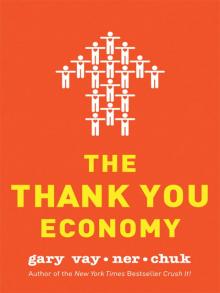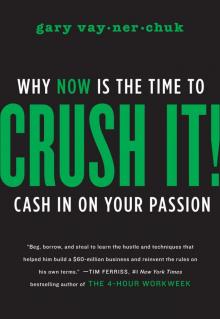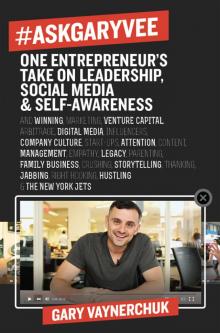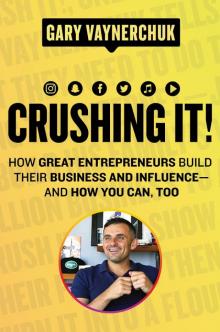- Home
- Gary Vaynerchuk
The Thank You Economy Page 8
The Thank You Economy Read online
Page 8
In the end, no matter what obstacles a company faces in the Thank You Economy, the solution will always be the same. Competitors are bigger? Outcare them. They’re cheaper? Outcare them. They’ve got celebrity status and you don’t? Outcare them. Social media gives you the tools to touch your consumer and create an emotion where before there might not have been one. It doesn’t matter if you’re not small or cool or sexy—people can get pumped up about the craziest stuff. I mean, really, who could have predicted the guy in a trench coat pulverizing iPhones in a blender? (Seriously, if you haven’t seen it, check out willitblend.com. It’s fantastic!)
There is one thing that the speaker at the 1997 Chamber of Commerce dotcom talk got right: in the end, it is the businesses that have established strong relationships with their customers that will come out on top. It’s unfortunate that so many companies had to fall by the wayside while the Thank You Economy took shape, but now that it’s here, the playing field is becoming shockingly equal.
PART II
How to Win
CHAPTER FOUR
From the Top: Instill the Right Culture
I can point to the date when the Thank You Economy’s existence became a matter of public record. It was July 22, 2009, a Wednesday. That’s the day it was announced that Amazon had bought Zappos for $1.2 billion.
Jeff Bezos is a hell of a smart guy, yet I heard more than one venture capitalist insider mutter that Zappos pulled a coup. There’s just no way the online retail company was worth that much money, they said. But Zappos wasn’t overpriced, and Bezos knew exactly what he was doing.
It seems to me that anyone who knows Bezos’s track record and still criticizes this acquisition is someone for whom numbers tell the entire story. I, on the other hand, don’t care what the numbers say, because I know that no company’s whole story can be read in the black-and-white columns of a P&L statement. And I think Bezos knows that, too. I think he looked into the future, and the future was Zappos. Here was a company that, according to off-the-record sources, was outselling Amazon on some non-footwear products that Amazon sold for less. There are only two things that will convince consumers to pay more for something when they could pay less. One is convenience, and the other is an outstanding customer experience. A lot of companies can play the convenience card, but very few companies, including Amazon, do customer service like Zappos. By dominating in both categories, they were the only retail threat to Amazon, and they’re only going to get bigger and better as their customer relationships deepen and their word of mouth continues to spread. No one outcares like Zappos. This wasn’t a buy based on numbers; it was a buy based on culture and trends. That’s why Bezos is a visionary. I think he sees that culture is the next playing field, just as he saw that ecommerce was the next playing field. He wouldn’t spend almost a billion dollars on anything but the future.
He doesn’t explicitly say this in the YouTube video that he made to explain the buy. What he does say is, “I get all weak-kneed when I see a customer-obsessed company, and Zappos certainly is that.” He also makes the point that he believes Amazon and Zappos are compatible because they both obsess over customer service (though as Tony Hsieh points out in the letter he wrote to Zappos employees to announce the deal, they do it in different ways). Specifically, what he says is, “When given the choice of obsessing over competitors, or obsessing over customers, we [Amazon] always obsess over customers.”
Bezos hasn’t asked for my advice, but I’m going to give it anyway. If he or anyone else wants to dominate in the Thank You Economy, there’s one more obsession that has to take root that isn’t mentioned in his video. Success in the Thank You Economy hinges on obsessively caring about the customer, yes, but a great caring culture stems from the top of a company and cascades through it like a waterfall. If you want that culture to flow outside of the company to the customer, and then get carried even farther by word of mouth, you have to be sure that your messengers live and breathe it the same way you do. Therefore, the dominant obsession for any leader running a company in the Thank You Economy shouldn’t be the competition, nor should it be customer service. It should be your employees.
One-to-One Management
Zappos has an amazing work environment. There’s free food in the cafeteria, a library, and a lot of happy employees. I’m willing to bet that most of the companies that are praised for outstanding customer service also fall pretty high on the scale of great places to work. It’s got to be awfully hard for employees to give phenomenal customer service when they’re not phenomenally satisfied with their jobs. Zappos’ perks, however, and those that are offered at other companies, such as casual Fridays or a glass keepsake on one’s fifth anniversary, aren’t what actually lead to employee satisfaction. I think it’s safe to say that Vaynermedia is a great place to work, but we’re twenty people crammed into a tiny space, and we don’t give out free snacks or even knock off early on summer Fridays. I work my staff to the bone. Still, I know they’re happy, because while perks might make employees think harder before deciding to leave, there are only two things that make employees really, really happy and make them want to stay.
The first thing that makes an employee happy is being treated like an adult. That means that until people prove that they can’t be trusted, they should be allowed to manage their job as they see fit. The second is feeling that his or her individual needs are being met. This is rare. To achieve this kind of satisfaction among staff would require business leaders to engage at the same one-on-one level with their employees as with their customers. Until now, not many companies have been up to the challenge. It does sound daunting, but it doesn’t have to be. It’s merely a matter of establishing a truly caring culture at the top, and applying Thank You Economy principles internally as well as externally.
For example, at Vaynermedia, we recently established a new vacation policy: there is none. The policy is, take as much or as little vacation as you want. At first it threw everyone off a little. What would be considered too much vacation? Then my staff figured out that I was serious, and that they would not be judged by how much vacation they took. Some have taken a solid amount; some have taken none. What matters is that they all get to decide for themselves how much time off they need in order to perform their job at the highest level when they are working, which means caring their face off for our clients, for each other, and for the brand. I don’t see how I can make that call for them. Some people have kids; others don’t. Some people have family that lives nearby; others have to travel long distances to visit loved ones. Some people just need a little more downtime to recharge than others.
I do have some basic rules. I’m passionate about team building, so I don’t hire anyone who wants to work from home on a regular basis. We need to be available when our clients are working, so project managers need to be in by 9:00 and the execution team should be in by 10:30 a.m. But within those parameters, I let my staff manage their time themselves. What difference does it make what time they leave, or how much vacation they take, so long as they are there when I, their colleagues, or their clients need them, they are doing their job 110 percent at all times, and they’re meeting their objectives?
I care more about my employees than I do about my customers, and I care more about my customers than I do about breathing. I am a naturally touchy-feely guy, and at work I’ve been like a mother hen (one with a huge competitive streak, for sure), constantly checking in on my employees, talking to them, and, when I can, making sure they have the latitude and resources to solve whatever problems they encounter. I’ve made it a priority to know what’s going on professionally, and often personally, with everyone on my staff. The constant dialogue, which helps me confirm that my employees feel they are being allowed to position themselves to succeed, has made it easy for me to see which people aren’t pulling their weight or who isn’t the right person for the job. Thanks to the communication facilitated by the open, trusting, caring culture of the company, however, it has been extremel
y rare for me to have to let anyone go.
Unfortunately, the employees of Wine Library have probably benefited more from this kind of attention than those at Vaynermedia. I’ve had to travel much more since launching Vaynermedia, and it’s been impossible to get as close to each individual employee, to get a true sense of who the people are and what they need. I do my best—I’m probably an All Star player right now. But at Wine Library, I was a Hall of Famer. I want to be the same way at Vaynermedia, and I have every intention of doing so as soon as possible.
So as you can see, even I, who run relatively small companies, can find it difficult to keep up with the kind of one-on-one employee service required by the Thank You Economy. How could it possibly be incorporated into a larger company? Some companies are proving that it’s possible. Zappos has done an outstanding job of creating an employee-centered company culture, and there are others who have made some smart moves and experimented successfully with giving their employees free rein, such as Best Buy, with its twittering Twelpforce. Eventually the companies in the best position to dominate will adapt many of these companies’ ideas, and then take them even farther. I predict that one day every company will have, along with a CEO, CFO, COO, and CSO, someone with a title like CCO—Chief Culture Officer—whose job will be to keep track of the needs of every single employee at the company. Not keep track of every employee; that would still be HR’s job. Keep track of their needs, and meet them to the best of the CCO’s ability, not through empty pep talks and token gifts but through individualized goal setting, strategizing for the future, and constant confirmation that the employee is satisfied. I’d love a job like this. If I didn’t want to buy the New York Jets, I’d be pestering every Fortune 500 company who would listen to let me create the position of CCO so I could show them what a major difference someone in that role could make to their bottom line. Everyone knows that turnover costs a company a fortune; a CCO’s salary could easily pay for itself just from the amount of money saved in lowered recruitment and retraining resources. What companies don’t realize is how much extra money they would earn if employees loved them so much, they took it upon themselves to work harder and longer than they would otherwise. With a CCO on staff to help make sure each worker has a reason to feel that way about his or her employer, companies could find themselves manned less by dedicated staff centered around a job, and more by passionate armies devoted to a cause.
But for a mid-to-large company, being an effective CCO would require getting to know a massive number of people on an individual level, wouldn’t it? Absolutely. It would be doable if all the other cultural building blocks to a Thank You Economy company had been established.
Cultural Building Blocks
Putting those building blocks in place could occur only once the company’s leadership dedicated itself to making it happen, of course. If a leader were so inclined, here’s how it could be done:
1. BEGIN WITH YOURSELF. Since culture stems from the top of a company, one would hope that the top exec has a good sense of who he or she is. Strong self-awareness makes a strong culture possible. Remembering who you are and the qualities that have made you successful until now, whether you’re a CEO, an executive, or a mid-level manager, is extremely important as you work toward developing, sustaining, and spreading the company culture. It won’t happen if you try to wear anyone’s hat but your own. If you’re buttoned up and formal, don’t try to become hip and casual. If you’re a conservative company, be a conservative company; just be a conservative company that puts its employees first, and its customers ahead of everything else. There’s a way to do that without installing a foosball table or allowing people to wear flip-flops to the office. I hate it when companies give their offices a face lift and open a lounge or floor where employees can play Nintendo Wii and eat free Twizzlers, as if to announce, “See how young at heart we are? We know what the kids want!” Self-aware leaders don’t waste a lot of time or money trying to be something they’re not.
In addition, leaders have to commit to the Thank You Economy before they can tell others to do so. Only once it is ingrained in your overall vision and strategy can you successfully spread it through your company or department. The Thank You Economy is based in authenticity, and authenticity has to begin with you.
2. COMMIT WHOLE HOG. No one can be expected to turn over a sizable portion of the company’s marketing budget to customer service–enhancing social media initiatives overnight, but the mental commitment can be made in a millisecond. The mental commitment is probably even more important than the financial commitment, especially in the early stages of preparing a company for the Thank You Economy. After all, there are going to be speed bumps and wrong turns and flat tires along the way. But if the leaders of the company are unwavering in their determination to create a culture of supersized caring, none of those setbacks will slow the company down for long. At the same time that you’re weaving care-your-face-off cultural DNA into the company, you can closely analyze your spending so you can take a practical approach to finding the money you need to implement creative, authentic social media initiatives. Stop blindly spending, reexamine your staff, start haggling harder for the best deals, and revisit the agencies and vendors you work with. The money is there; it’s just being spent in the wrong place.
3. SET THE TONE. As soon as leaders commit to building a caring culture, they need to send a strong, direct message about their intent. Employees should be able to feel the difference immediately, and they should be able to look to their leaders for examples of the kind of care, concern, and one-on-one interaction with customers that will be expected of them.
John Pepper, the CEO of Boloco, a Boston-based burrito chain, has done this brilliantly. Internally, he and his cofounders have made it clear that the welfare and future of Boloco’s employees are paramount, from providing health care to all full-time and most hourly employees to offering English and Spanish classes to all staff in an effort to improve in-house communication and allow non–English-speaking workers to rise to roles of greater responsibility. His employees can also look to him as a role model. His engagements on social media offer plenty of examples of the kind of personal, caring interaction he expects them to engage in with customers. For example, by searching Twitter for the word “Boloco,” he caught someone sitting right outside a store located on the Boston Commons, complaining that the music was set too loud. He alerted the manager, who immediately lowered the volume and then came out to make sure the music level was set to the customer’s satisfaction.
What followed next should prove the impact of the Thank You Economy.
The happy customer sent out a new tweet praising Boloco for its customer service.
Many of her followers started twittering about what had just happened.
She then wrote an entire blog post about her experience, which you can read about in her post, “Music, Burritos, and the Impact of a Tweet,” on her blog, Rachel Levy: Social Media and Marketing.
The story got retold in a book.
A lot more people have now heard of Boloco and its awesome burritos.
Would you care to put a dollar amount on the earned media Boloco gained through one great act of customer service? (I hope it’s a lot, because that would mean many people had bought this book!)
More dramatically, Pepper sets the tone by sidestepping around the corporate-speak walls most leaders hide behind. You can see it in the way he answers customer comments from the heart. A perfect and praiseworthy example is the letter he wrote to a customer who was disappointed that Boloco had taken his favorite burrito off the menu.
–—Original Message–—
From: John Pepper [mailto:[email protected]]
Sent: Tuesday, January 24, 2006 8:31 P.M.
To: Ben
Subject: RE: Boloco.com: customer response
Ben,
First of all, thanks for your note. We always appreciate hearing from customers…even if we’ve done something that doesn’t make them
happy, it helps us a great deal.
We worried a lot about Roasted Veggies and what the reaction would be. The reason they disappeared in the first place is because so few people actually ordered them, and the amount of prep time and waste (because they’d sit too long and we’d have to throw them out) stopped justifying keeping them on the menu years ago…but because of the few, and outspoken, customers who lived on them, we kept them in place. You are now the 7th person that has written about this loss since we took them off three months ago (not including a handful of our employees who are also quite upset).
From a purely business standpoint, it didn’t make any sense to keep the Roasted Veggies. From a customer loyalty standpoint, however, your note (and the others like it) makes me want to get them back on the menu tomorrow! The challenge we always have is balancing the two…you would be amazed at the number of requests we get on a weekly basis from our customers—obviously, we can’t accommodate everyone, but we do listen to everyone, and consider what they say carefully.

 The Thank You Economy
The Thank You Economy Crush It!
Crush It! #AskGaryVee
#AskGaryVee Crushing It! EPB
Crushing It! EPB Jab, Jab, Jab, Right Hook
Jab, Jab, Jab, Right Hook